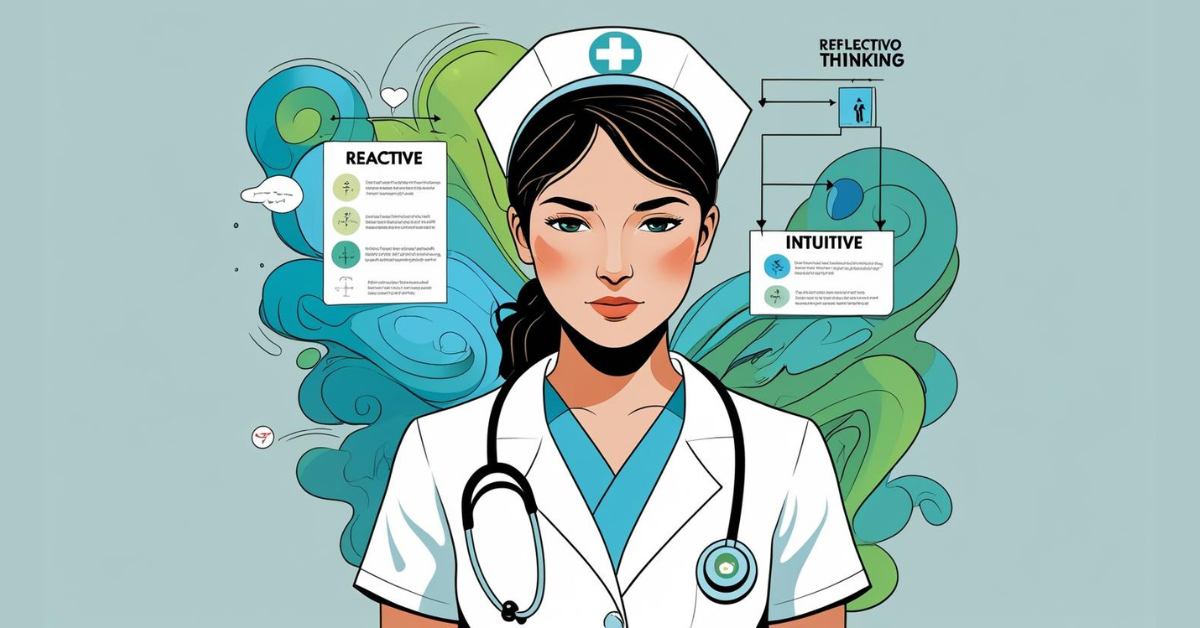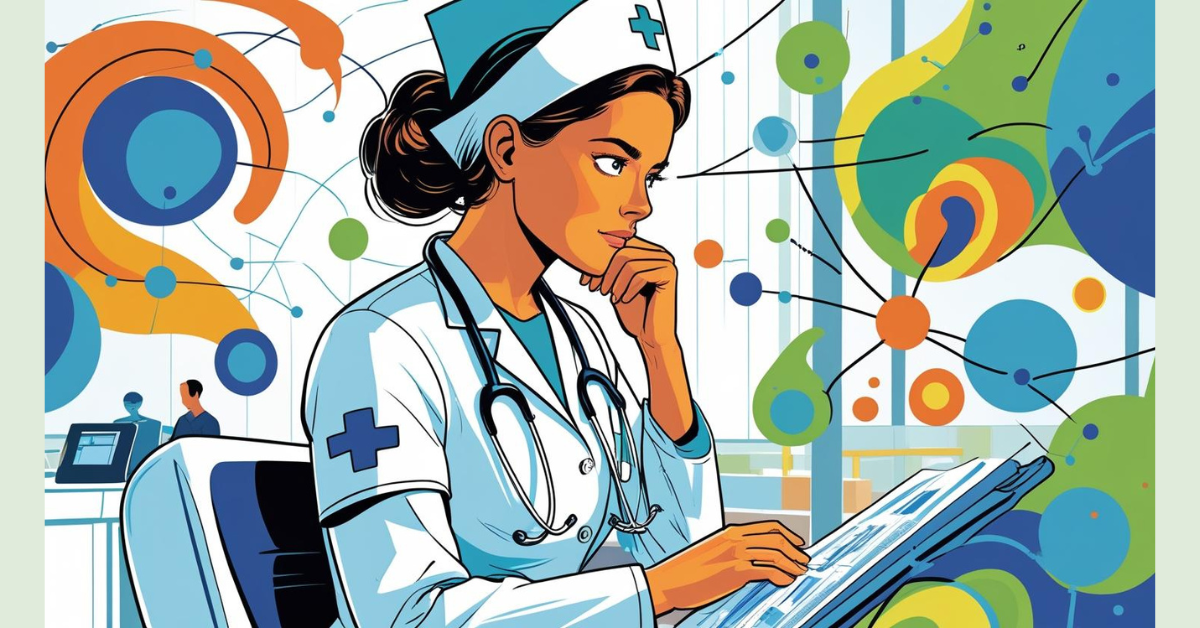What is Modeling Critical Thinking by Reactive Reflective and Intuitive Thinking In Nursing Practice. Reflective action is more than a method; it is a way of thinking that enables nursing leaders to learn from their actions, make informed decisions, and motivate their teams toward excellence.
The Modeling Critical Thinking by Reactive Reflective and Intuitive Thinking In Nursing Practice
Critical thinking in nursing practice encompasses a multifaceted approach that integrates reactive, reflective, and intuitive thinking. Nurses use these thinking styles to analyze situations, make informed decisions, and provide effective patient care. This integration promotes clinical reasoning, problem-solving, and, ultimately, treatment outcomes.
Through critical reflection, nurses understand the contextual meaning of a situation and reconstruct their experiences to apply what they have learned in practice and thus discover the purpose of nursing. Critical thinking in nursing involves identifying a problem, determining the best solution, and implementing an effective problem-solving method using clinical decision-making skills. This is followed by reflection.
Intuition, known as “gut feelings” or “knowing without reason” (Hassani et al., 2016), is used by nurses to support decision-making. Melin-Johansson et al. (2017) defined intuition as the rapid evaluation and synthesis of knowledge and experience. Through critical reflection, nurses reflect on their experiences and ask themselves the “why” of the care situation. This broadens their thinking and allows them to fully understand the context of the situation.
Reactive, Reflective, and Intuitive Thinking
Nurses use critical thinking to explore, understand, analyze, and apply knowledge in various practice situations. Not engaging in critical thinking when caring for patients, making decisions, or dealing with challenging situations can result in the use of reactive thinking. Reactive thinking is an automatic or kneejerk reaction to situations that has consequences leading to vague or inaccurate reasoning, sloppy and superficial thinking, and poor nursing practice (Heaslip, 2008; Zori & Morrison, 2009).
Nurse leaders and managers who engage in reactive thinking use automatic, thoughtless responses to solve problems that often result in errors or ineffective decision making. Consider the following scenario: Several nurses are going back to school to advance their education, and they approach the nurse manager about implementing a different scheduling method that would allow nurses to work every weekend with extra days off during the week, rather than the current practice of scheduling all nurses to work every other weekend.
The nurse manager does not believe that the proposed scheduling method would be fair to all nurses and refuses to consider any changes. In this example, the nurse manager does not consider input from the staff, makes an assumption without taking any time to think about the decision critically, and does not give staff the opportunity to engage in shared decision making, thus possibly resulting in nurse dissatisfaction. The nursing staff members will probably not challenge the nurse manager’s decision because they may not feel comfortable discussing the topic further.
Reflective thinking restricts innovation and maintains status quo (Zori & Morrison, 2009). Rather, critical thinking should involve some reflection on previous experiences to analyze a situation, make judgments, and draw conclusions. Reflective thinking consists of deliberate thinking and understanding using one’s own personal experiences and knowledge, and it involves assessing what is known, what needs to be known, and how to bridge the gap between the two (Masters, 2014).
Reflective thinking requires thoughtful personal self-assessment, analysis, and synthesis of strengths, all of which can help nurses develop the skill of self-improvement. Using reflective thinking, nurses must examine and question underlying assumptions and their validity (Benner, Hughes, & Sutphen, 2008). When engaged in reflective thinking, nurses (Masters, 2014, p. 221):
- Determine what information is needed for understanding the issue.
- Examine what has already been experienced related to an issue.
- Gather available information.
- Synthesize the information and opinions.
- Consider the synthesis from different perspectives and frames of reference.
- Create some meaning from the relevant information and opinions.
Nurse leaders and managers find that using reflective thinking in complex situations is beneficial because it forces them to step back, assess the situation, and think about how to solve the problem. Reflective thinking can result in fewer errors and more effective decision making. Considering the situation just discussed, using reflecting thinking when the staff members makes their request, the nurse manager tells the staff members that she will consider alternative scheduling methods. She reviews the organization’s staffing policies and determines that a change is feasible.
The nurse leader and manager create a team and asks for nurses from all shifts to volunteer to be part of the team. At the first meeting, she outlines the current policies and charges the team to determine the number of nurses willing to work weekends and to identify a feasible schedule to ensure safe staffing. After input from all staff members, the team finalizes a feasible schedule, which is then implemented. By engaging in reflective thinking, the nurse manager promotes shared decision making among the staff members, who then feel empowered and satisfied with the scheduling process.
There are instances in which nurses claim to use intuition or “gut feelings” when providing patient care. Intuitive thinking is an instant understanding of knowledge without supporting evidence. It has also been described as an intuitive grasp or a clear understanding of a situation based on a background of similar situations (Benner, 1984).
Some reject intuition as an element of critical thinking because it is abstract and seems irrational. However, intuition is a cognitive skill used by nurses to assist assessment of situations and can lead the nurse to take quick action in the delivery of safe, effective patient care (Robert, Tilley, & Petersen, 2014). Intuitive thinking is a non conscious state of knowing that integrates memory and pattern recognition without cognitive direction (Payne, 2015).
Expert nurses do not rely on critical thinking alone; rather, they form an intuitive understanding of a patient’s situation based on previous knowledge, experiences, and pattern recognition (Benner, 1984; Payne, 2015). Nurse leaders and managers use intuitive thinking as they deal with day-to-day unit-level situations. Intuition is based on previous knowledge and experience and triggers a response or reflection to resolve an issue.
Modeling Critical Thinking
Nurses use critical thinking continually while caring for patients, coordinating care, collaborating with others, advocating for patients, problem solving, resolving issues, and ensuring that safe and quality patient care is provided. One’s ability to think critically can be affected by many factors such as age, education, experience, and work environment. Nurse leaders and managers play a pivotal role in helping staff members enhance their critical thinking skills (Ignatavicius, 2001).
A major function of nurse leaders and managers is to be a role model for staff by being critical thinkers themselves. In addition, staff members rely on nurse leaders and managers to help solve clinical, interpersonal, and unit-related problems. Nurse leaders and managers who use reflective thinking and provide guidance to staff in a credible manner will create a sense of trust and safety on the unit (Zori, Nosek, & Musil, 2010).
In contrast, nurse leaders and managers who engage in reactive thinking may miss opportunities for self-growth, to role model critical thinking for staff, and to create changes that are long-lasting and goal driven (Zori & Morrison, 2009). In an evidence-based practice world, it is becoming increasingly important that nurse leaders and managers articulate to staff the value and application of critical thinking as a normal expectation of professional nursing practice (Porter-O’Grady et al., 2005).
Nurse leaders and managers must encourage staff to analyze situations, challenge assumptions, explore alternative options, and embrace continuous improvement. Enforcing the expectation of using critical thinking with rewards and recognition can result in a positive work environment. The encouragement of critical thinking by nurse leaders and managers creates a legitimate foundation for accurate and effective decision making on the unit (Porter-O’Grady et al., 2005).
Read More:
https://nurseseducator.com/didactic-and-dialectic-teaching-rationale-for-team-based-learning/
https://nurseseducator.com/high-fidelity-simulation-use-in-nursing-education/
First NCLEX Exam Center In Pakistan From Lahore (Mall of Lahore) to the Global Nursing
Categories of Journals: W, X, Y and Z Category Journal In Nursing Education
AI in Healthcare Content Creation: A Double-Edged Sword and Scary
Social Links:
https://www.facebook.com/nurseseducator/
https://www.instagram.com/nurseseducator/
https://www.pinterest.com/NursesEducator/
https://www.linkedin.com/in/nurseseducator/
https://www.researchgate.net/profile/Afza-Lal-Din
https://scholar.google.com/citations?hl=en&user=F0XY9vQAAAAJ


